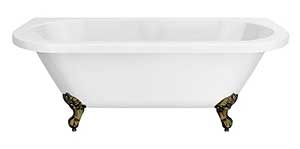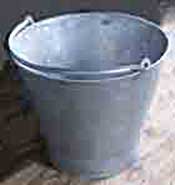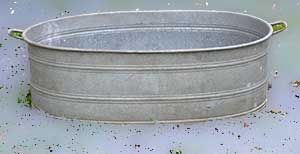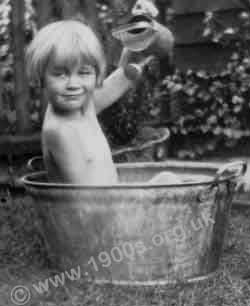
How did Victorians bath?

Bathing for ordinary working-class Victorian families was very different from how wealthy families on large estates bathed. Ordinary people did not have the luxury of bathrooms with plumbed in baths. Adults generally kept themselves clean by washing themselves at the scullery sink, but baths were available in houses on 'modern' Victorian housing estates. This page describes the hard work involved in getting a full-sized hot bath for an adult. Children did have regular baths, and the page also describes how this was done.
____
Extracted from the memoirs of the webmaster's mother(1906-2002) and edited by the webmaster with further research and firsthand contributions from others
On the Victorian housing estate where I grew up, there was a full-sized bath in the house. It was upstairs inside a large cupboard in a small room which was called the off-room - and which in later years had the grand name of bathroom. You can see it on the floor plan.
The adult bath
For practical reasons this bath was hardly ever used because it was not plumbed in, had no taps and no hole for drainage.

Basic adult Victorian bath with no taps or drain, not plumbed in
The bath stood on legs, probably to keep the floor open to the air in what might be a damp atmosphere.
How the bath was filled
If someone wanted the luxury of a bath, they had to work for it. They first had to fill the copper in the scullery with water, then light the copper fire, which incidentally could be very temperamental. Then, once the water was hot, they had to bail it out into buckets and carry it upstairs.

Galvanised tin bucket, as used for filling a copper and carrying hot water from the copper to the bath. Photographed in Fagans Museum of Welsh Life.
A bath took a number of bucketsful, so was never filled very deeply. The full buckets were heavy and it was all too easy to spill the hot water and scald oneself.
Bathing in front of the fire as we grew older
In my family, we did bath in front of the kitchen range as we grew older, using a long tin bath. Then to preserve our dignity, everybody except the bather had to stay out of the room for the duration.
Albert Smith

Tin bath brought in from outside for adults to bath in by the kitchen range
Any attempt to move these baths while water was in them was a mistake because even the slightest of movements created a wave which could flood the floor.
Albert Smith
How the bath was emptied
After the bath, the dirty water had to be emptied. This was another major operation.
Any attempt to move these baths while water was in them was a mistake because even the slightest of movements created a wave which could flood the floor.
Albert Smith
Baths were usually emptied by bailing out the water with a large jug and pouring it back into the buckets which were then carried either to the drain in the scullery sink or directly onto the garden.
I understand that some households siphoned the water out of the bath into the buckets, but siphoning was only possible if the bath was sufficiently raised off the floor.
Finally, the bath had to be wiped round with a cloth to clean and dry it, and spills had to be mopped up.
No wonder adults generally just had a good wash at the scullery sink, and also no wonder that public baths were so popular.
Bathing and hairwashing for children
It was standard practice for children to be bathed on Saturday nights in a tin bath in front of the open coal fire in the kitchen. The kitchen was effectively our living room and it always felt cosy.

Playing in a tin bath in the 1930s. A winter bath for children would look like this but in front of a coal fired kitchen range.
Bathing us children was - like everything else for my mother - hard work. Because there was no running hot water anywhere on the Victorian housing estate, bathing necessitated lighting the fire of the copper well in advance and then pouring buckets of water into it to heat up.
Then, when the water was hot, it had to be bailed out of the copper into buckets and carried to the tin bath in the kitchen. Alternatively, there could be several kettlesful, heated on the kitchen range, and mixed with cold water.
What it was like to be bathed as a child
We children bathed one at a time in the same water. The soap was ordinary household soap.
We had our hair washed while sitting in the bath. Our hair was lathered with the household soap and then rinsed with a jug of warm water poured over our heads. There wasn't time to say, "Ouch, it's too hot" or, "Ooooh, it's cold!".
Spiders in the bath
Because the bath spent the rest of the week outside in the yard, it had to be cleared of spiders and spiders' webs, etc. before we had our bath.
Vera Harding, formally Vera Eaton
After children were bathed: clean clothes and more
We children always had our clean night clothes put on after our baths, followed by a dose of brimstone and treacle, which was rather ridiculous as it made me feel sick and, if I was, I risked dirtying my clean nightdress which my mother had gone to so much effort to wash and iron earlier in the week. Brimstone and treacle was a laxative, which, it was considered, was always necessary for children once a week.
Sometimes after our bath my mother would you read to us. I only remember two books Peep behind the scenes and Cast your bread upon the waters. The first book was about circus life where a little girl called Rosaly lived with her mother in a caravan. The mother was very ill with consumption and little Rosaly had to perform in a circus every night. I think the reason for me to remember this so well was because I was fascinated with the little girl's dress which was a typical circus dress, it had a tight bodice and a billowing white skirt with red roses round at the bottom. Actually it was a very sad story. The other book, I suspect had a moral to it and was based on the proverb, Cast your bread upon the waters and ye shall find it to returned after many days. It left no lasting impact on me.
If you can add anything to this page or provide a photo, I would be pleased if you would contact me.
Text and images are copyright
sources: early 20th century material
sources: ww2 home front and other material
contact
the webmaster/author/researcher/editor
privacy policy
















